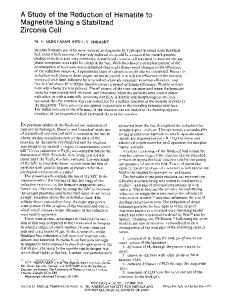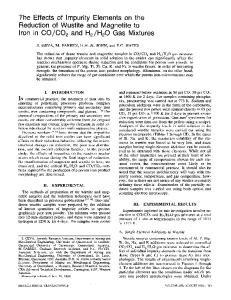Microstructural Changes and Kinetics of Reduction of Hematite to Magnetite in CO/CO 2 Gas Atmospheres
- PDF / 2,254,912 Bytes
- 11 Pages / 593.972 x 792 pts Page_size
- 2 Downloads / 348 Views
INTRODUCTION
The gaseous reduction of hematite, Fe2O3, is the first step in the industrial scale production of metallic iron, and the outcomes can significantly influence subsequent reduction steps and overall iron making process efficiency. For this reason, the reducibilities of iron ores are routinely measured to quantify the relative performance of different iron ores.[1,2] Despite the apparent simplicity of the overall chemical reaction, the mechanisms and kinetics of reactions in this gas/solid system are quite complex. There remain fundamental aspects of the reduction steps that are still not well characterized or not understood. Previous research on the gaseous reduction of hematite, Fe2O3 to magnetite, Fe3O4 in CO/CO2 gas atmospheres has shown that the reduction product can be in the form of dense (lath) magnetite or microporous magnetite.[3–11] The magnetite product morphology is dependent on the reduction temperature and gas composition. Experimental studies indicate that the dense, lath magnetite product structures are formed at lower thermodynamic driving forces for reduction. The lath structure can be explained by a ‘‘military’’ or shear transformation that takes place along a common phase boundary, that is the close packed oxygen plane shared by the hexagonal (hcp) structure of Fe2O3 and the face
JIANG CHEN, RUIHAN ZHANG, TEGAN SIMMONDS, and PETER C. HAYES are with the Pyrometallurgy Innovation Centre (PYROSEARCH), The University of Queensland, Brisbane Q4072, Australia. Contact e-mail: [email protected] Manuscript submitted February 16, 2019.
METALLURGICAL AND MATERIALS TRANSACTIONS B
centered cubic (fcc) structure of Fe3O4. This results in the change from ABABAB packing of oxygen layers in Fe2O3 to ABCABC pattern in Fe3O4. In contrast, the porous magnetite structure appears to involve a reconstructive transformation, involving the diffusion of elements in the region of the growing Fe2O3/ Fe3O4 interface. The porous magnetite product structures are formed at relatively higher thermodynamic driving forces for reduction. At low temperatures, the pores formed in the magnetite structure have been reported to form of cellular structures.[5,6] Figure 1 shows an example of the porous magnetite structure formed on reduction of dense Fe2O3 at 573 K (300 °C) in 1 atm. H2.[6] The magnetite microstructure is in the form of colonies of connected, cellular nano-sized gas pores at the Fe2O3/ Fe3O4 interface. It can be seen from this figure that, under these conditions, the pores are almost circular in cross section approximately 5 to 10 nm in diameter. At present, the only estimated chemical reaction rate data available for the reduction of hematite to magnetite are that reported in References 12 through 15; these data are only approximate since they were determined from indirect weight loss measurements on granular materials. The particular focus of the present study is to provide further information on the structure of the Fe2O3/Fe3O4 interface during reduction and the kinetics of reduction in CO/CO2 gas mixtures.
II
Data Loading...











